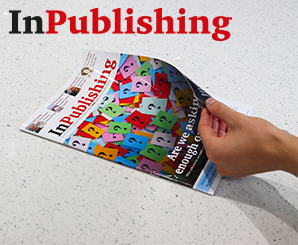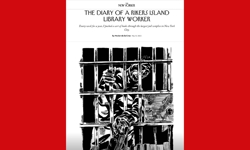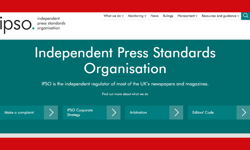
Things have not gone well for Oliver Duff in terms of realising his early ambitions.
He wanted to be Arsenal goalkeeper and had to admit by the age of 30 that time had finally run out on that one, and he has to be content with being “a long suffering fan” of the club.
Apart from that, he wanted to be an explorer but has had to make do with membership of the Royal Geographical Society and scuba-diving and swimming with sharks off the Bahamas.
Third time round, Oliver Duff, editor-in-chief of the i newspaper, has had both more luck and success.
Recently the paper, sold by the Independent Media Group to what was then Johnston Press three years ago, won the Media Brand of the Year award at the British Media Awards.
The accolade was achieved despite the “financial turbulence” surrounding Johnston Press, which was bought out of administration late last year by JPIMedia, a consortium of the company’s bond holders.
“We were obviously delighted. It was a lovely surprise and it felt like recognition for editorial, commercial, marketing and publishing teams who are punching above their weight,” says Duff who was the fourth employee on the innovative paper.
Early this year, there was another small accolade which Duff values just as much.
PAMCo, the organisation that measures the performance of newsbrands across all platforms, found that inews.co.uk, the newspaper’s website set up only three years ago, was considered the most trustworthy by its readers.
Its trust rating of 89 per cent was ahead of both The Guardian and the Independent.
The main print edition came third behind the Yorkshire Post, also part of the JPIMedia group, and The Guardian but ahead of The Times.
The new website was set up against the clock with a skeleton crew when new owners Johnston Press said they wanted an online presence from day one after the £24 million purchase.
“We were quite cautious because we didn’t want to damage the brand so it was thrilling to see the PAMCo rating,” says Duff who says he asks himself for every piece of journalism he commissions – will people be willing to pay for this now or over time.
“It’s also about protecting your brand, it’s having the integrity that goes alongside, it’s respecting your audience,” says Duff, at 35, the youngest national newspaper editor.
The i was launched in 2010 in the face of a recession and declining enthusiasm for print and “people thought we were crazy, and with good reason” the paper’s editor-in-chief acknowledges.
Other attempts to find a new national or regional niche in the daily newspaper market in recent times have fallen rapidly by the wayside.
The i’s promise is to cut through the noise in an age of hyper-information.
Launch concept
The same might easily have happened to the i because Duff admits the new paper didn’t work at the outset and indeed that the original approach was “messed up”.
The initial thought was that the paper would be a fluffy, slightly up-market version of the Metro, city-centric, firmly aimed at urban audiences.
The reality turned out to be something rather different. They found out that 85 per cent of the i print readership, and later inews.co.uk, came from outside London and the last thing they wanted was fluff or celebrity stories.
“Our readers told us, we just want news and we come to you because we are unhappy with what we are getting elsewhere, just give it to us straight,” says Duff. In fact, more than half of them haven’t read a newspaper before.
Alongside the importance of news, brevity was also at the heart of the i approach so that there would be no “buyer’s remorse” paying for piles of newsprint that went largely unread.
“I have a stack of New Yorkers which are probably a structural danger to some of my colleagues and there’s probably brilliant journalism in them but how do you find the time,” Duff asks.
So, the i’s promise is to cut through the noise in an age of hyper-information and that, the editor believes, is the biggest single reason that people come to the paper.
The aim was also to innovate in print with integrated teams across platforms and placing audience data at the heart of its journalism.
“It feels like some have lost faith in print though there are clearly others who clearly haven’t if you look at the strength of The Times offering and you can see the way that the Financial Times is investing in its journalism,” Duff notes.
We are not having to go down a route that relies on clickbait in order to grow.
The i ethos
In his column as editor on June 13th 2013, the first of more than 1,400 daily columns, some written late in the evening, Duff set out his stall by promising he would maintain the paper’s founding principles of quality, brevity and open dialogue with its readers.
“Feel free to get in touch with old gripes and new wheezes. In return, we promise honest journalism, a progressive view of the world and to tell it straight,” Duff wrote.
The aim is to be fair but not, the i editor emphasises, in the sense of offering a BBC sort of balance.
“We don’t try to create a kind of ersatz balance in our coverage but we try to be fair and if all political leaders think we give them a bit of a hard time as a result, that’s good for us,” he says.
But apart from mainly living outside London and wanting news rather than fluff, who are the i readers?
In print, 55 per cent are male although the title skews 55 per cent female online, reaching young professionals, although the age range is wide.
“They are travelling into cities and they want a quality read for a condensed period of time. Our readers are clever busy people and they want a paper without an axe to grind,” he says.
They are interested in the political experience but do not want to be told what to think, an i policy that began emerging during the Scottish referendum when Duff decided it to be crazy for a bunch of mainly London-based journalists to try to tell the Scots what to do.
Instead, the i launched a ‘You Decide’ campaign, an approach that continued during the Brexit referendum and during the general election.
“On the one hand, you can be accused of fence-sitting. The defence against that is having a really vibrant range of columnists who have a furious battle of ideas in the paper and online every day,” says Duff who adds that one of the most popular pages in the print edition is the Opinion Matrix of different views.
As a “young upstart”, the paper was able to make some obvious gains such as a “much meatier, more impressive” weekend edition which seeks to go beyond a weekly digest with columnists and investigations.
One of the paper’s best exclusives last year – which caused a noticeable spike in terms of audience in both the paper and online, was a story that three universities were on the brink of bankruptcy and had to call in financial help.
“It is really exciting to see that we are not having to go down a route that relies on clickbait in order to grow,” says Duff.
Circulation at 230,000 for the daily and 260,000 for the weekend edition with 50,000 bulks is down by 8 per cent year-on-year but the figures have been influenced by a series of price rises.
The i now costs 65p during the week and £1 at the weekend. Subscriptions cost £2.80 a week for the paper with a digital edition priced at £4.99 a month.
In May, inews.co.uk had 9.4m unique visitors – more than The Times whose numbers are paywall limited – but also more than HuffPostUK.
The package all adds up to expected profits this year of more than £12 million.
It’s a model for us – I wouldn’t prescribe it for everyone – a core of staff journalists being supplemented by multiple outside sources.
The publishing model
At the same time, the number of staff has increased by around 20 to 90 with, in addition, 100 or so freelancers to call on. The aim is to generate more journalism in-house, reflecting a changing editorial model.
In the first three years, there was a deal that allowed the i to take any amount of copy from The Independent. There is now more of a skinny deal involving the “very best” of Independent correspondents. There are agreements with other sources including the Financial Times, The Economist and the Washington Post.
The i can draw on the investigative unit that combines resources across JPIMedia.
“It’s a model for us – I wouldn’t prescribe it for everyone – a core of staff journalists being supplemented by multiple outside sources,” Duff explains.
The biggest uncertainty facing Duff and the i is the attitude and future plans of JPIMedia.
Will the title be sold off to the highest bidder at some point? Is Duff worried about what the future holds?
“Not in the least. Over the last few years, I have worked for Irish, Russians and now Americans. They have been great. We have spent a fair bit of time with them and they are excited about owning the i brand. They can see the potential,” Duff explains.
He finds it “invigorating” that JPIMedia is giving strategic backing and taking a five-year view of the business but believes as editor he has to remain “restless” looking for new ways to do things.
“I tend to refer to it as a work in progress and it always will be,” Duff emphasises.
“In five years’ time, whoever is editing the paper, much as I am enjoying it, I would like to see the print product still vibrant and lively with a prosperous future still ahead of it, and all our business forecasts suggest that, as well as growing the digital subscription product,” Oliver Duff suggests.
He will also keep exploring ways to ensure that the i continues to punch above its weight.
This article was first published in InPublishing magazine. If you would like to be added to the free mailing list, please register here.












